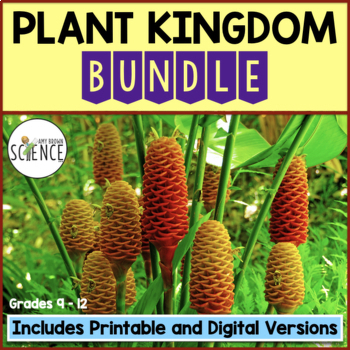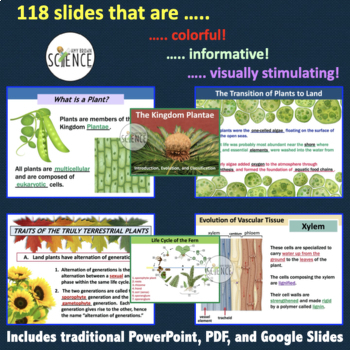Plant Kingdom Bundle
- Zip
- Google Apps™

What educators are saying
Products in this Bundle (11)
showing 1-5 of 11 products
Bonus
Description
This complete teaching unit on "The Plant Kingdom: Introduction, Evolution, and Classification" includes everything you need to teach this unit to your life science or biology students. Resources include an 118-slide PowerPoint presentation packed with colorful and interesting photographs and images, teacher notes, printable and digital student notes, task cards, labs, lab stations, study guides, homework assignments, crossword puzzles, a graphic organizer, quizzes, and a final unit test. Includes everything you need right at your fingertips for a complete unit on the Plant Kingdom.
From the engaging PowerPoint to the final unit test, this bundle contains loads of NO PREP materials that are ready to be used with your students. Many of the resources in this bundle are available in paperless digital formats for use in Google Drive, Google Classroom, Microsoft OneDrive, or similar. Both Google Slides and Google Forms Versions are included.
What is included in this bundle? ( Items marked with ** have both printable and digital versions.)
- 118-Slide PowerPoint with Notes for Teacher and Student **
- Plant Kingdom Task Cards (79 task cards) **
- Lab: Liverworts, Mosses, and Ferns
- Lab: Plant Kingdom Chat Lab Stations
- Lab: Monocots and Dicots
- Homework Assignments - Set of 4 **
- Plant Kingdom Quizzes - Set of 4 **
- Plant Kingdom Graphic Organizer Study Aid **
- 2 Crossword Puzzles
- 130-Slide Review Question PowerPoint
- Plant Kingdom Unit Test **
- Bonus file: Bundle Teacher Guide containing tips for implementation and suggestions for sequencing.
When appropriate, I have included each product as an editable Word document, and I have also included each product in pdf form.
All answers are included.
Topics Covered Include:
- Introduction to Plants: Characteristics of plants and the plant life cycle (alternation of generations.)
- Plant life cycle: Alternation of generations, sporophyte and gametophyte generations, haploid and diploid phases, the production of spores by meiosis, flow chart showing alternation of generations.
- The Transition of Plants to Land: Ancestors of plants, advantages to living on land, problems of living on land, evolutionary solutions that allowed plants to thrive on land.
- Students will label a cladogram showing the evolution of mosses, liverworts, ferns, gymnosperms, and angiosperms.
- Traits of Terrestrial Plants: Alternation of generations, spores produced in sporangia, multicellular sex organs, apical meristems, vascular tissue, nonmotile gametes, a root system, protection from dehydration.
- Classification Differences Between Nonvascular Plants and Vascular Plants: The presence (or absence) of xylem and phloem, bryophytes, tracheophytes, seed plants, seedless plants, gymnosperms, angiosperms, monocots, and dicots.
- Flow chart showing the classification of the land plants.
- Characteristics of the Bryophytes: Examples of bryophytes, explanation of why the bryophytes are still tied to a watery existence, bryophytes are nonvascular plants, bryophytes have a dominant gametophyte generation.
- The Liverworts: Characteristics, reproduction, students will label a life cycle diagram of liverworts.
- The Mosses: Characteristics, reproduction, students will label a life cycle diagram of mosses.
- Ferns - The Seedless Vascular Plants: The evolution of vascular tissue and its importance to life on land, detailed explanation of xylem and phloem
- How ferns are adapted to a life on land, but not completely adapted as a seedless plant.
- The Fern: Characteristics, reproduction, students will label a life cycle diagram of ferns.
- The Seed Plants: Gymnosperms and Angiosperms
- Seed Plants: The advantage of reproduction free from water, adaptations that allow for reproduction without water.
- Cones, Flowers, Pollen, and Seeds
- Characteristics of Gymnosperms
- Characteristics of Angiosperms
- Monocots and Dicots
For updates about sales and new products, please follow my store:
I would love to have you follow me at these locations as well:
My Blog: Amy Brown Science.com
Instagram: @AmyBrownScience





